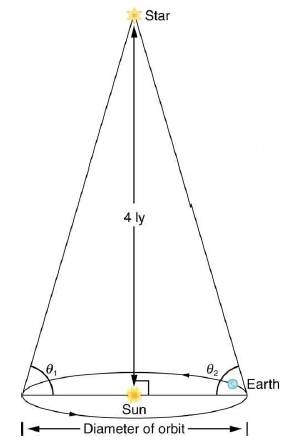
Concept explainers
Construct Your Own Problem
Consider a star moving in a circular orbit at the edge at a galaxy. Construct a problem in which you calculate the mass of that galaxy in kg and in multiples of the solar mass based on the velocity of the star and its distance from the center of the galaxy.

Figure 34.26 Distances to nearby stars are measured using triangulation, also called the parallax method. The angle of line of sight to the star is measured at intervals six momma apart, and the distance is calculated by using the known diameter of the Earth's orbit. This can be done for stars up to about 500 ly away.
Want to see the full answer?
Check out a sample textbook solution
Chapter 34 Solutions
College Physics
Additional Science Textbook Solutions
Sears And Zemansky's University Physics With Modern Physics
University Physics with Modern Physics (14th Edition)
Physics for Scientists and Engineers: A Strategic Approach, Vol. 1 (Chs 1-21) (4th Edition)
University Physics Volume 1
Essential University Physics: Volume 2 (3rd Edition)
- The radius Rh of a black hole is the radius of a mathematicalsphere, called the event horizon, that is centered on the blackhole. Information from events inside the event horizon cannotreach the outside world. According to Einstein’s general theory ofrelativity, Rh = 2GM/c2, where M is the mass of the black hole andc is the speed of light.Suppose that you wish to study a black hole near it, at a radialdistance of 50Rh. However, you do not want the difference in gravitationalacceleration between your feet and your head to exceed10 m/s2 when you are feet down (or head down) toward the blackhole. (a) As a multiple of our Sun’s mass MS, approximately what isthe limit to the mass of the black hole you can tolerate at the givenradial distance? (You need to estimate your height.) (b) Is the limitan upper limit (you can tolerate smaller masses) or a lower limit(you can tolerate larger masses)?arrow_forwardThe Andromeda Galaxy is the closest large galaxy and is visible to the naked eye. Estimate its brightness relative to the Sun, assuming it has luminosity 1012 times that of the Sun and lies 0.613 Mpc away.arrow_forwardThe nearest neutron star (a collated star made primarily of neutrons) is about 3.00 1018 m away from Earth. Given that the Milky Way galaxy (Fig. P1.81) is roughly a disk of diameter 1021 m and thickness 1019 m, estimate the number of neutron stars in the Milky Way to the nearest order of magnitude. Figure P1.81arrow_forward
- (a) What Hubble constant corresponds to an approximate age of the universe of 1010 y? To get an approximate value, assume the expansion rate is constant and calculate the speed at which two galaxies must move apart to be separated by 1 Mly (present average galactic separation) in a time of 1010 y. (b) Similarly, what Hubble constant corresponds to a universe approximately 21010years old?arrow_forwardThe distance of a galaxy from our solar system is 10 Mpc. (a) What is the recessional velocity of the galaxy? (b) By what fraction is the starlight from this galaxy red shifted (that is, what is its z value)?arrow_forwardIn the Check Your Learning section of Example 27.1, you were told that several lines of hydrogen absorption in the visible spectrum have rest wavelengths of 410 nm, 434 nm, 486 nm, and 656 nm. In a spectrum of a distant galaxy, these same lines are observed to have wavelengths of 492 nm, 521 nm, 583 nm, and 787 nm, respectively. The example demonstrated that z=0.20 for the 410 nm line. Show that you will obtain the same redshift regardless of which absorption line you measure.arrow_forward
- Using Wien's Law for two black body objects with a temperature of 1000 K (fire) and 290 K (background), at what central wavelengths are the two objects radiating?arrow_forwardAt rest hydrogen has a spectral line at 149nm. If this line is observed at 144nm for the star Proxima, how fast is Proxima moving in km/s?arrow_forwardpls send answer of both the part immidiately and i will rate you sure sirarrow_forward
- Calculate the velocity of a star moving relative to the earth if you observe a wavelength of 91.0 nm for ionized hydrogen capturing an electron directly into the lowest orbital (that is, a ni = ∞ to nf = 1 , or a Lyman series transition).arrow_forwardWhat is the frequnency of an X-ray with lambda = 200 picometers?arrow_forwardWhat is the wavelength in micrometers of peak emission for a black body at 33.5°C? (c = 3.0 × 108 m/s, Wien displacement law constant is 2.9 × 10-3 m ∙ K, σ = 5.67 × 10-8 W/m2 ∙ K4). Please give your answer with one decimal place.arrow_forward
 College PhysicsPhysicsISBN:9781938168000Author:Paul Peter Urone, Roger HinrichsPublisher:OpenStax College
College PhysicsPhysicsISBN:9781938168000Author:Paul Peter Urone, Roger HinrichsPublisher:OpenStax College Physics for Scientists and Engineers: Foundations...PhysicsISBN:9781133939146Author:Katz, Debora M.Publisher:Cengage Learning
Physics for Scientists and Engineers: Foundations...PhysicsISBN:9781133939146Author:Katz, Debora M.Publisher:Cengage Learning University Physics Volume 3PhysicsISBN:9781938168185Author:William Moebs, Jeff SannyPublisher:OpenStax
University Physics Volume 3PhysicsISBN:9781938168185Author:William Moebs, Jeff SannyPublisher:OpenStax AstronomyPhysicsISBN:9781938168284Author:Andrew Fraknoi; David Morrison; Sidney C. WolffPublisher:OpenStax
AstronomyPhysicsISBN:9781938168284Author:Andrew Fraknoi; David Morrison; Sidney C. WolffPublisher:OpenStax College PhysicsPhysicsISBN:9781305952300Author:Raymond A. Serway, Chris VuillePublisher:Cengage Learning
College PhysicsPhysicsISBN:9781305952300Author:Raymond A. Serway, Chris VuillePublisher:Cengage Learning Principles of Physics: A Calculus-Based TextPhysicsISBN:9781133104261Author:Raymond A. Serway, John W. JewettPublisher:Cengage Learning
Principles of Physics: A Calculus-Based TextPhysicsISBN:9781133104261Author:Raymond A. Serway, John W. JewettPublisher:Cengage Learning





